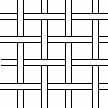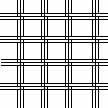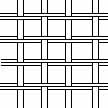Needlepoint Canvas, a stiff fabric where the holes take up more space than the threads, is the basic ground (the base fabric for an embroidery) we use to do needlepoint. Woven on special looms that space the threads a specific distance apart we use it but how much do we know about it?
The Weaves

Mono canvas has a basic over-1-under-1 weave, also called a tabby weave. Congress Cloth is also a mono canvas.
The important characteristic of mono canvas is that the intersections are not locked in place so they can be moved. That allows use to use specialty stitches and techniques and it makes finishing easier.
The majority of hand-painted and high-quality computer-printed canvases use mono canvas, pictured, above.

Penelope canvas is far more popular in Europe than in the US. It has two threads where mono canvas has one.
The important characteristic of Penelope canvas is that the pairs of threads can be separated. This means you can easily do both Petit Point and regular needlepoint on the same canvas. Penelope, or duo, canvas is pictured above.

Interlock canvas, like mono, has only one thread in each direction. However the horizontal, or weft, threads, are actually two threads, wrapped around the intersections , so they lock them in place.
Silk gauze and garment canvas are interlock canvases.
This characteristic means that interlock allows this canvas to be thinner and lighter. It also means you can cut very near the stitching without worrying about raveling. Thus, it’s great for clothing, accessories and 3-D objects.
You will find interlock canvas, pictured above, most often in kits in the US.
Needlepoint Canvas Questionnaire
If you have a piece of canvas in front of you, You can easily ask questions to determine the type of canvas.
- Are there two threads in each direction?Then your canvas is Penelope.
- Can you easily unravel a thread from an edge that isn’t a selvage? If you can do this for more than an inch, you’re canvas is mono. If you can only do it for a couple of threads, it’s probably interlock. Go to the next question.
- Can you significantly enlarge a hole and then move the threads back into place with your needle? Then your canvas is mono. If you cannot your canvas is interlock.
Recognizing Quality Canvas
Most shops only carry high-qualliy canvas, but you can find lower quality in many kits. The best needlepoint canvas, in all weaves, comes from Zweigart. If you have a selvage it will have orange threads running through it.
If you do not have a selvage, recognizing quality is harder but still possible. Here’s what to look for:
- In all canvases the holes will be clean and free of fiber strands and sizing. Shorter fibers are a characteristic of poor-quality threads. When you see fibers in the holes of your canvas, not only is it poor-quality but it will be harder on your threads.
- In Mono canvas the threads will be very thick for the size of the hole, thicker than the threads in other canvases. If you unravel a thread you will see that it is very smooth and just a bit shiny.
- Penelope and Interlock threads will be thinner than mono threads, but the holes will be clean with sharp edges.
- The canvas will be stiff. Softer canvas means either the stock is old, or not enough sizing was used. In either case it will be harder to stitch because needlepoint canvas needs to be taut. This is true for all canvases except soft Congress Cloth, silk gauze, and garment canvas, which are not sized.
How did the design get onto the Canvas?
The type of canvas has an effect on the way the artist can put the design on canvas.
On Mono canvas you can use acrylic paints (hand-painted), oil paints (not often used today), or high-end computer printers (giclee).
If your canvas has not been produced by these methods, it has been mechanically produced either by silk screen (high-end) or printing (low-end). I recently learned that the inks used in these processes will not work on mono canvas. I don’t know why but I do know they do not use acrylic inks/paints.
About Janet M Perry
Janet Perry is the Internet's leading authority on needlepoint. She designs, teaches and writes, getting raves from her fans for her innovative techniques, extensive knowledge and generous teaching style. A leading writer of stitch guides, she blogs here and lives on an island in the northeast corner of the SF Bay with her family

I have inherited 2 canvases that have the centers all ready done. They just need the background filled in. My question is what color of yarn do I want to use? Can I use a 4py knitting yarn for the background?
Any help would greatly be appreciated.
Thanks,
Anita Bydlowski
In terms of what thread you can use, everything depends on the mesh of the canvas (how many threads per inch). Like knitting yarns, threads for needlepoint come in different thicknesses or weights.
If by 4-ply knitting yarn you mean worsted weight yarn, it is too thick for needlepoint canvas. If the mesh size of the canvas is 12 or 14 you might be able to use sock weight knitting yarns. But you are better off buying a wool made for needlepoint.
Wool is your best bet for a thread for the background of the piece. The color that will work best really depends on your taste. Look at my article about background color in this blog (https://nuts-about-needlepoint.com/picking-the-right-background-color/) for some considerations.
Keep stitching,
Janet
If I have mono canvas that the selvage has been removed, how do I decide which side to use or does it matter? I know the selvage should be on the left.
Thank you
To figure out which way it should go you will need to remove two canvas threads one each from adjacent sides (remember which is which). The one that is wavier should be the side that is vertical.
This happens because the vertical, or warp, threads are under more pressure as the cloth gets woven and therefore will bend more.
Keep stitching,
Janet
I purchased a beautiful painted needlepoint canvas. It is a portrait of two people. It is on 10/20 Penelope canvas. There are no instructions, no chart, only a suggested thread list. They recommend DMC Floss.
I have done some simple needlepoint it the past but nothing as difficult as this. I have trouble seeing the spaces and when I do the pettipoint and it looks messy. Not at all like the samples I have found on line.
I also don’t understand the need for turning the whole project upside down every row. I have the piece mounted on stretcher bars and I use a floor stand to hold it. With so much shading on the face I only do a few stitches at a time before I go to the next row so turning is tedious to say the least.
I have done a lot of counted cross stitch in the past and do not need to turn the work over.
Would it be possible to convert the design to counted cross stitch? If so how would be the best way to do it? As I stated earlier, I do not have a chart. I just have the painted canvas to work from. Thanks.
Let’s talk about several things here that are causing some of your problems.
First, the turning upside down. This is one way of stitching Continental and you find it often in books. However, you CAN stitch Continental beautifully without doing this. The key is always to take the longest path from the end of one stitch to the beginning of the next. That means that in one row you might stitch from top to bottom, In order to keep taking the longest path when yo stitch from the other direction you’ll be stitching from bottom to top.
When your row is going from top to bottom, stitch left to right.
When your row is going bottom to top, stitch right to left.
When your row is going left to right, stitch top to bottom.
When your row is going right to left, stitch bottom to top.
The second issue is the Petitpoint parts of your canvas, probably the face. Penelope canvas as it comes from the mill has big holes and very little holes. If you try to stitch the petitpoint areas with the canvas like this it will look bad and very uneven. What you need to do is enlarge the holes BEFORE you stitch. You just do this by pushing the threads away from you with your needle. Make sure when you stitch the petitpoint areas that there are at least 3-4 open threads around the area because that helps give the threads room to move.
Your last question is about converting the printed canvas to counted cross. Yes you could use the canvas as your “chart” but because you are planning to do parts of this canvas as petitpoint, the larger stitches will equal four cross stitches. If you stitched on linen, you could do the petitpoint as over one stitches and the large stitches as over two stitches. Cross stotch has far less texture than needlepoint and uses more colors. You might find that your finished cross stitch does not look very exciting.
Keep stitching,
Janet
Thanks, Janet. I will try again. This piece is too beautiful to ruin. So I want to learn to do it right. Your instructions for doing the Continental stitch are better than any I have read in the books.
The other thing I have to figure out is how many strands of thread to use to get good coverage. I think that will have to be trial and error though. Fortunately there is plenty of “practice” area along the sides that I can try different things with before I stitch on the real piece.
Thanks for the compliment! I love Continental but it took me years to figure out that way to explain it.
Do you know what mesh the canvas is? If it’s 10/20, try 8 strands for the 10 and 3 for the 20. Do a few rows in the margin & adjust up or down. If you can see light through the canvas when you hold it up, it’s too thin. If the canvas threads are distorted it’s too thick.
You also might want to practice the petitpoint part in the margins until you feel confident. Since you are using floss, don’t worry about the color.
Keep stitching,
Janet
Thanks for the advice. I am anxious to put it to good use. It will be a couple of weeks before I can though. I have tendinitis in my right hand and it is in a cast until then. I can be studying it and thinking about though.
Kathie
I have a question about canvas sizing. I make koozies for soda (I’m not much of a beer drinker, but they’ll probably fit as well) cans. For anyone interested, it takes 120 stitches for the circumference using 14 count mono canvas with 56 (give or take) vertical stitches. All the edges are lapped over at least 4 stitches, and the circumference is lapped at least 8 stitches to prevent stretching apart, so the entire piece is locked. Using 6 strand cotton floss, the items are 100% cotton. I wish for them to be limp and floppy, like a sock, because they fit and stick better. So, my question is this: How do I remove all the sizing? I’ve washed and washed and washed these things and it seems to take at least a half dozen washings before it begins to limp. More washings, even better. There must be a better way to remove the sizing. What do you recommend? These koozies are a big hit, by the way. Hint: After washing, stretch them onto UNopened cans and allow to dry.
You might think about soaing the canvas in a sink full of water instead of using repeated washings. I have had pretty good luck woth this & it will be easier on the threads.
Keep stitching,
Janet
Actually, I have thought of and tried soaking the canvas (including the floss, i.e. the completed koozie) in a jar filled with detergent water. No need to monopolize the whole sink for such a small item. There did not seem to be any difference between soaking overnight versus just scrubbing and rinsing. I’m beginning to wonder if the sizing might not in fact be starch, but perhaps instead some synthetic substitute. Whatever it is, it seems to be quite resistant to ordinary laundry detergent. This could very well be by design. Most projects would tend to hold shape better after blocking with the sizing intact. For koozies, however, they’re nicer when limp and floppy. The sizing eventually comes out, but it takes at least a dozen washings or more. Thanks for your input.
Hello, I’ve been finding your advice and replies very helpful. I’ve recently started a lovely Margot of Paris 10/20 Penelope canvas. I received it with stranded cotton and am using 8 strands for the 10 count background areas and 3 strands for the 20 count finer detail. But I’m not sure what to do where the two “meet up” and I need to do small stitches with the background colour to fill in the final gaps or small areas of background colour. Should I switch to 3 strands of background colour or try to use 8 even for these smaller stitches?
In the areas between your smaller stitches and the larger stitches, you would need to add small stitches in the correct color, to bring them up to where they can meet up evenly with the larger stitches. This should only be a stitch or so, and in some rows won’t be needed at all.
Keep stitching,
Janet